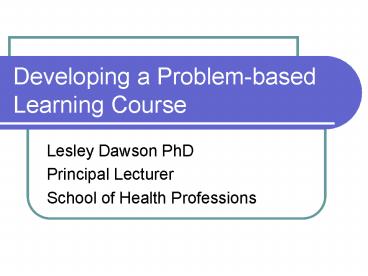Developing a Problembased Learning Course - PowerPoint PPT Presentation
1 / 31
Title:
Developing a Problembased Learning Course
Description:
... programme leading to a qualification in physiotherapy with eligibility for ... ( Hons) in Physiotherapy. We also have a post-graduate, post-qualification ... – PowerPoint PPT presentation
Number of Views:25
Avg rating:3.0/5.0
Title: Developing a Problembased Learning Course
1
Developing a Problem-based Learning Course
- Lesley Dawson PhD
- Principal Lecturer
- School of Health Professions
2
MSc Rehabilitation Science
- An entry-level masters programme leading to a
qualification in physiotherapy with eligibility
for membership of the Chartered Society of
Physiotherapy and registration by the Health
Professions Council
3
Issues in curriculum design
- Masters degree
- Entry level/pre-qualification
- Accelerated
- Problem-based learning
4
What is PBL ?
- Problem-Based learning (PBL) is a system of
teaching and learning where, without prior
preparation, small groups of students consider an
unfamiliar situation, problem or task.
5
How does it work?
- By exploring the nature of this unfamiliar
situation, the students share prior knowledge and
experience. - As they progress, they pose questions which they
need to explore in order to progress the task.
6
What is PBL ?
- After a period of individual study and other
supportive educational experiences, they discuss
what they have learned and how this relates to
the original situation.
7
Teachers role
- Teachers adopt the roles of facilitators and
managers of the students learning
8
Why Problem-Based Learning?
- Integrates subjects
- Promotes team working
- Promotes independent learning
- Promotes critical thinking/clinical reasoning
- Encourages life long learning
- Promotes Evidence Based Practice
9
A typical weekly timetable
10
Year 1 Timetable
11
Year 2 Timetable
12
How can you monitor learning?
- Module Tutors provide PBL Tutors with a Tutor
Guide - This outlines the topics and questions they would
like students to consider
13
PBL Tutorials
- During tutorials a white board or flip chart is
used to record discussion - What do we know about this problem ?
- What ideas do we have about the problem and how
we might deal with it? - What do we need to learn before we can deal with
this problem ? - How and where will we learn these things?
14
Comparisons with undergraduates
- We have a successful B.Sc. (Hons) in
Physiotherapy - We also have a post-graduate, post-qualification
masters degree in physiotherapy
15
Comparisons with undergraduates
- We went for the same clinical education model
- We went for clinical education at Level 3
- We are still struggling with the appropriate
level between undergraduate and post qualification
16
Curriculum challenges
- Chose a range of patient scenarios/situations
that a newly qualified physiotherapist would be
expected to deal with - Brain storming of topics associated with each
scenario eg anatomy, physiology, pathology,
psychosocial issues, research issues, assessment,
treatment and management issues
17
Curriculum challenges
- Mapping of associated topics across all the
problems - Ordering of problems so that each problem
built on the knowledge, attitudes and skills of
the previous problem
18
Issues around Applications and Acceptance
- Selecting students who can cope with the pace and
volume of work - Misconceptions about first degree
19
How can we select students who can cope ?
- What we look for in applications
- type of degree
- degree classification
- work experience
- research project
20
How can we select students who can cope ?
- What kind of students are we looking for?
- students who can work in a team
- students who can reflect on and in practice
- students who are independent learners
- students who can hit the ground running
21
How can we select students who can cope ?
- Selection process
- group discussion following a video trigger
- written reflection of group performance
- individual interview
22
Adapting to new Teacher Roles
- PBL Tutors
- Fixed Resource Sessions
- Skills Sessions
23
Assessment of learning
- Evaluation of participation in tutorials
- Assessment of practical skills related to
problems - Innovative course work eg patient education
leaflets, information folder for carers etc - Assessment by clinical educators
24
Worries about getting it all in
- Staff development workshops in PBL
- Involvement of all staff in curriculum design and
design of problems, triggers, tutor guides - Good communication between PBL tutors, skills
sessions and FRS tutors - Monitoring meetings after each module
25
Getting the level right
- Consultation with existing course teams
- Trimester 1 modules at level 3
- Clinical modules at level 3
- Careful choice of External Examiner
- Still struggling with level..
- BUT
26
Feedback from 2nd year students 2004/5
- PBL approach enables us to develop skills for
accessing information in the practice setting - Through the PBL process we build up a picture
and know where to go in the medical notes to
access information
27
PBL and communication in the practice setting
- We have to deal with challenges during
- PBL tutorials and resolve issues this approach
helps us to work through challenges in the
practice setting - ..the PBL approach makes us feel more confident
to facilitate communication with educator if we
feel unhappy about the placement
28
Feedback from practice educators
- Students are very open to feedback
- PBL students work collaboratively and support
each other - PBL approach makes students flexible in their
approach to patient management
29
An example of a Trigger
- Thank you for seeing this young man who was seen
in A and E on the 31st July after sustaining a
dislocation to his right shoulder during a game
of rugby. This was reduced after an Xray revealed
no fracture. He is also complaining of a painful
right wrist, there are no findings on Xray and
therefore we are suspicious that he has a soft
tissue injury.
30
Tutorial Form
31
Tutor Guide































